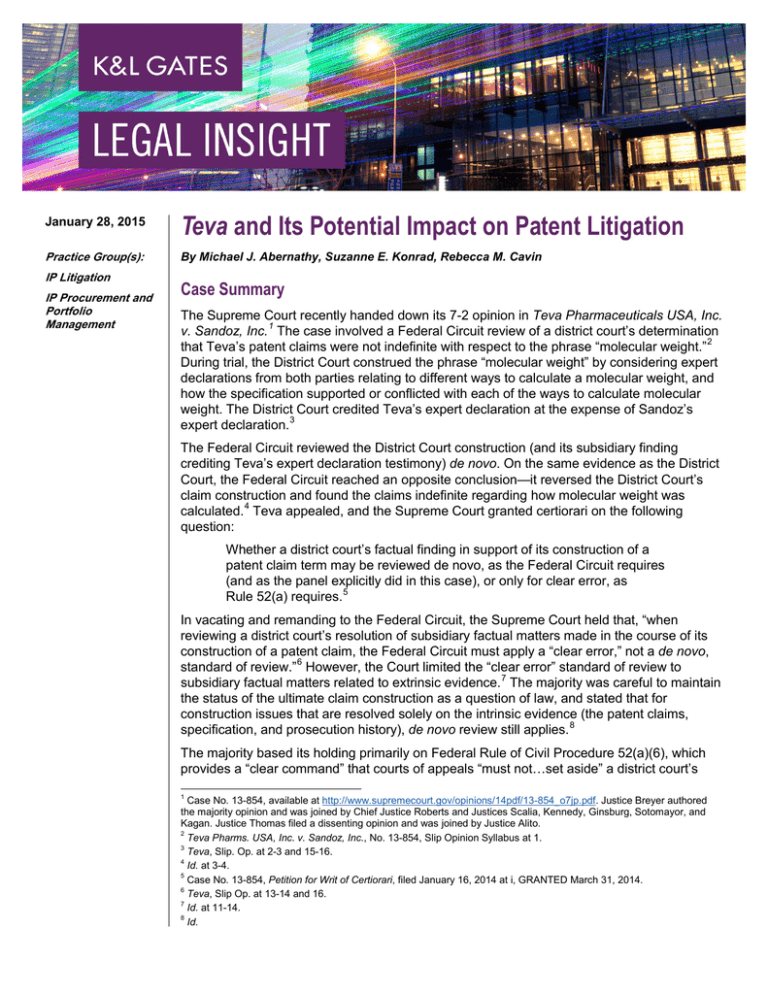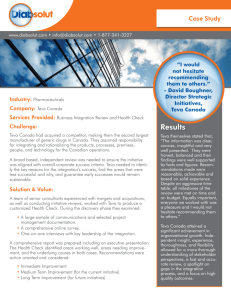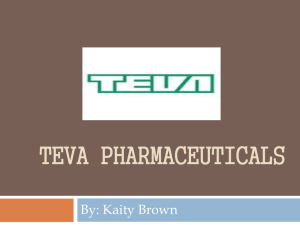
January 28, 2015
Teva and Its Potential Impact on Patent Litigation
Practice Group(s):
By Michael J. Abernathy, Suzanne E. Konrad, Rebecca M. Cavin
IP Litigation
Case Summary
IP Procurement and
Portfolio
Management
The Supreme Court recently handed down its 7-2 opinion in Teva Pharmaceuticals USA, Inc.
v. Sandoz, Inc. 1 The case involved a Federal Circuit review of a district court’s determination
that Teva’s patent claims were not indefinite with respect to the phrase “molecular weight.” 2
During trial, the District Court construed the phrase “molecular weight” by considering expert
declarations from both parties relating to different ways to calculate a molecular weight, and
how the specification supported or conflicted with each of the ways to calculate molecular
weight. The District Court credited Teva’s expert declaration at the expense of Sandoz’s
expert declaration.3
The Federal Circuit reviewed the District Court construction (and its subsidiary finding
crediting Teva’s expert declaration testimony) de novo. On the same evidence as the District
Court, the Federal Circuit reached an opposite conclusion—it reversed the District Court’s
claim construction and found the claims indefinite regarding how molecular weight was
calculated. 4 Teva appealed, and the Supreme Court granted certiorari on the following
question:
Whether a district court’s factual finding in support of its construction of a
patent claim term may be reviewed de novo, as the Federal Circuit requires
(and as the panel explicitly did in this case), or only for clear error, as
Rule 52(a) requires. 5
In vacating and remanding to the Federal Circuit, the Supreme Court held that, “when
reviewing a district court’s resolution of subsidiary factual matters made in the course of its
construction of a patent claim, the Federal Circuit must apply a “clear error,” not a de novo,
standard of review.” 6 However, the Court limited the “clear error” standard of review to
subsidiary factual matters related to extrinsic evidence. 7 The majority was careful to maintain
the status of the ultimate claim construction as a question of law, and stated that for
construction issues that are resolved solely on the intrinsic evidence (the patent claims,
specification, and prosecution history), de novo review still applies. 8
The majority based its holding primarily on Federal Rule of Civil Procedure 52(a)(6), which
provides a “clear command” that courts of appeals “must not…set aside” a district court’s
1
Case No. 13-854, available at http://www.supremecourt.gov/opinions/14pdf/13-854_o7jp.pdf. Justice Breyer authored
the majority opinion and was joined by Chief Justice Roberts and Justices Scalia, Kennedy, Ginsburg, Sotomayor, and
Kagan. Justice Thomas filed a dissenting opinion and was joined by Justice Alito.
2
Teva Pharms. USA, Inc. v. Sandoz, Inc., No. 13-854, Slip Opinion Syllabus at 1.
3
Teva, Slip. Op. at 2-3 and 15-16.
4
Id. at 3-4.
5
Case No. 13-854, Petition for Writ of Certiorari, filed January 16, 2014 at i, GRANTED March 31, 2014.
6
Teva, Slip Op. at 13-14 and 16.
7
Id. at 11-14.
8
Id.
Teva and Its Potential Impact on Patent Litigation
“[f]indings of fact” unless they are “clearly erroneous.” 9 The majority reasoned that the rule
provides little room for exceptions, and that, in any event, no convincing grounds exist for
making an exception in the context of claim construction. After discrediting the idea that
Markman v. Westview Instruments, Inc., 517 U. S. 370 (1996), created such an exception,
the majority cited pre-Federal Circuit caselaw from the Second Circuit that applied the
“clearly erroneous” standard to underlying factual questions regarding how one of skill in the
art understood a claim term.10 The majority also noted that practical considerations favored a
clear error review, citing the trial court’s familiarity with the technical aspects of the case
rather than reading a bare written record. 11
The majority then addressed the arguments from Sandoz and the dissenting Justices. In
particular, Sandoz (and the Federal Circuit) argued that separating factual from legal
questions would be difficult in the context of claim construction and having a single standard
would be simpler and provide more uniformity. 12 The majority disagreed that difficulty was a
compelling reason to ignore Rule 52(a)(6), noting that courts frequently parse factual and
legal questions, and that even the single de novo standard has brought complexities. 13 With
respect to uniformity, the majority noted that a divergence of opinion on fact or the ultimate
claim construction should only occur occasionally, and that “subsidiary fact finding is unlikely
to loom large in the universe of litigated claim construction.”14
In response to the dissent, the majority quickly dismissed the concept that there are no
factual determinations in claim construction, citing its Markman decision, the question
presented (which assumes factual determinations), Sandoz’s concession that factual
determinations are made, and the posture of the Teva case itself. 15 The majority also
rejected the dissent’s argument that patents are analogous to statutes because: 1) the type,
length, and manner of public consideration before enacting a statute or awarding a patent
are meaningfully distinct, and 2) the Supreme Court has never previously compared patents
claims to a statute, instead analogizing patents to written contracts or deeds.16
The majority also provides some guidance on how to implement the fact/law distinction in
practice, holding that, in cases where a district court needs to look beyond the intrinsic
evidence and consult disputed extrinsic evidence (such as expert testimony), its findings on
the extrinsic evidence are entitled to a clearly erroneous review. 17 This is true even when
9
Id. at 4 (citing Anderson v. Bessemer City, 470 U.S. 564, 574 (1985) and FRCP 52(a)(6)).
Id. at 5-7.
11
Id. at 7-8. Although this point generally has some persuasive value, the authors of this article were surprised that the
opinion did not mention the fact that the expert analysis at issue in this case was not based on live testimony, but rather
on expert declarations. As Sandoz pointed out at oral argument, in the case of merely paper expert submissions, the
appellate court and the trial court would seem to be in the same position with regard to their ability to weigh the evidence
and make credibility determinations.
12
Id. at 8-9.
13
Id.
14
Id. at 9-10 (citing Markman, 517 U. S. at 389-90).
15
Id. at 10. The point raised by the dissenting opinion is, in actuality, more subtle. The dissent argues that factual findings
made during claim construction are not “findings of fact” under the Federal Rule, not that there are no factual
determinations at all. Teva, Dissent Slip Op. at 1.
16
Teva, Slip Op. at 11. The dissent argues that patents are more like statutes, in that they are governmental dispositions
that bind the general public, and less like contracts and deeds, which are specific and only govern the parties to the
written instrument. The dissent thus reasons that the factual determinations made in construing patent claims should be
treated the way factual determinations in statutory interpretation are treated—with de novo review. Teva, Dissent Slip Op.
at 2-14. The dissent also noted that the majority’s ruling is likely to cause problems with uniformity and “costly” and
“meritless. . . collateral litigation over the line between fact and law.” Id. at 14-15.
17
Id. at 11-14.
10
2
Teva and Its Potential Impact on Patent Litigation
these factual matters are nearly dispositive of the ultimate legal question of the proper
meaning of a term. 18 Nevertheless, the ultimate construction of a term is still a legal question,
reviewed de novo on appeal.19 Also, where only intrinsic evidence is necessary for claim
construction, all of the district court’s findings will be reviewed de novo, as they were prior to
the Supreme Court’s Teva opinion.20
After setting out the proper standard of review, the majority applied its holding to the central
issue of the trial court’s decision to credit Teva’s expert declaration at the expense of
Sandoz’s expert declaration. 21 The majority vacated and remanded this factual question, as
well as two others, for reevaluation by the Federal Circuit under a “clearly erroneous”
standard.22
Implications of Teva on the Federal Circuit and District Courts
Teva may not have a significant effect on how the Federal Circuit handles claim construction
appeals. First, the Supreme Court did not state generally that claim construction is reviewed
de novo. Instead, the Court reiterated the well-settled principle that the ultimate issue of
claim construction is a question of law reviewed de novo, and held that only factual
determinations arising from extrinsic evidence (i.e., credibility determinations regarding
experts) are reviewed for “clear error.”23 The Court specifically held that the interpretation of
intrinsic evidence, such as the patent and prosecution history, is solely a question of law
reviewed de novo.24
Second, a court need not rely on extrinsic evidence, and such evidence cannot be used to
contradict a claim construction dictated by the intrinsic evidence.25 Therefore, if the Federal
Circuit wants to review a particular claim construction de novo, it seems that Teva may have
left the door open for the Federal Circuit to review the intrinsic evidence de novo and state
that there is no need to consult extrinsic evidence to make the ultimate determination of
claim construction. As such, it remains to be seen whether the Teva case will have any
impact on the frequency or manner in which the Federal Circuit reviews claim construction
decisions on appeal.
On the other hand, Teva is likely to have an impact on how district courts construe patent
claims. In order to avoid being overturned on appeal, judges may try to ensure that their
claim construction decisions are based on factual determinations. As a result, district court
judges may rely much more heavily on extrinsic evidence, specifically credibility
determinations regarding experts, when issuing their Markman decisions.
18
Id.
Id.
20
See id.
21
Id. at 14-16.
22
Id.
23
Id. at 1 and 5-7.
24
Id. at 3.
25
Phillips v. AWH Corp., 415 F.3d 1303, 1322-24 (Fed. Cir. 2003).
19
3
Teva and Its Potential Impact on Patent Litigation
Effects of Teva on Litigation Practice
Regardless of how the courts choose to apply Teva, this decision will have a significant and
immediate impact on litigation practice. Both patent owners and accused infringers are likely
to consider relying much more heavily on extrinsic evidence to ensure that the claim
construction issued by the district court is robust on appellate review. In the Teva case, the
Supreme Court expressly held out crediting one expert over another as an example of a
factual determination that would be subject to “clear error” review on appeal.26 Therefore, the
authors of this article predict that it will become commonplace to secure an expert early on in
litigation for purposes of a Markman declaration. Litigants should think strategically about
whether an expert is desirable, particularly in cases where a party believes it has a strong
claim construction case based on the intrinsic record. Moreover, the authors expect there will
be significant pre-Markman motion practice to strike expert declarations that parties feel are
inappropriate.
Furthermore, appellants will need to carefully frame the issues on appeal. For example, in
Teva, the issue was framed as a factual one. Therefore, the Federal Circuit will have to
review the trial court’s determination regarding expert opinions for “clear error.” However,
since the Supreme Court specifically left the ultimate question of claim construction, as well
as determinations regarding the intrinsic evidence, as legal issues subject to de novo review,
it will be important for appellants to frame the claim construction issues as legal ones based
on intrinsic evidence in order to obtain a de novo standard of review on appeal. Conversely,
respondents that want to keep the district court’s claim construction will need to try to push
the claim construction analysis toward a review of extrinsic evidence and, thus, obtain a
“clear error” standard of review.
Conclusion
Although the Teva holding is not a sweeping rewrite of claim construction law, the Supreme
Court did clarify that claim construction is a matter of law that can be based on factual
determinations. 27 In order to overturn a judge’s resolution of an underlying factual dispute,
the Federal Circuit must find “clear error.” 28 Therefore, the Federal Circuit can no longer
disregard district court claim constructions as a matter of course and must give deference to
district courts at least with respect to underlying factual findings.
However, whether the Teva holding will alter the way the Federal Circuit treats district court
claim constructions remains to be seen. The Federal Circuit’s intent will likely be evinced
over the next several months through not only its decision on remand of the Teva case but
also subsequent claim construction decisions.
26
Teva, Slip Op. at 3.
Id. at 1-3.
28
Id. at 5-7 and 11.
27
4
Teva and Its Potential Impact on Patent Litigation
Authors:
Michael J. Abernathy
mike.abernathy@klgates.com
+1.312.807.4257
Suzanne E. Konrad
suzanne.konrad@klgates.com
+1.312.807.4378
Rebecca M. Cavin
rebecca.cavin@klgates.com
+1.312.807.4239
Anchorage Austin Beijing Berlin Boston Brisbane Brussels Charleston Charlotte Chicago Dallas Doha Dubai Fort Worth Frankfurt
Harrisburg Hong Kong Houston London Los Angeles Melbourne Miami Milan Moscow Newark New York Orange County Palo Alto Paris
Perth Pittsburgh Portland Raleigh Research Triangle Park San Francisco São Paulo Seattle Seoul Shanghai Singapore Spokane
Sydney Taipei Tokyo Warsaw Washington, D.C. Wilmington
K&L Gates comprises more than 2,000 lawyers globally who practice in fully integrated offices located on five
continents. The firm represents leading multinational corporations, growth and middle-market companies, capital
markets participants and entrepreneurs in every major industry group as well as public sector entities, educational
institutions, philanthropic organizations and individuals. For more information about K&L Gates or its locations,
practices and registrations, visit www.klgates.com.
This publication is for informational purposes and does not contain or convey legal advice. The information herein should not be used or relied upon in
regard to any particular facts or circumstances without first consulting a lawyer.
© 2015 K&L Gates LLP. All Rights Reserved.
5








